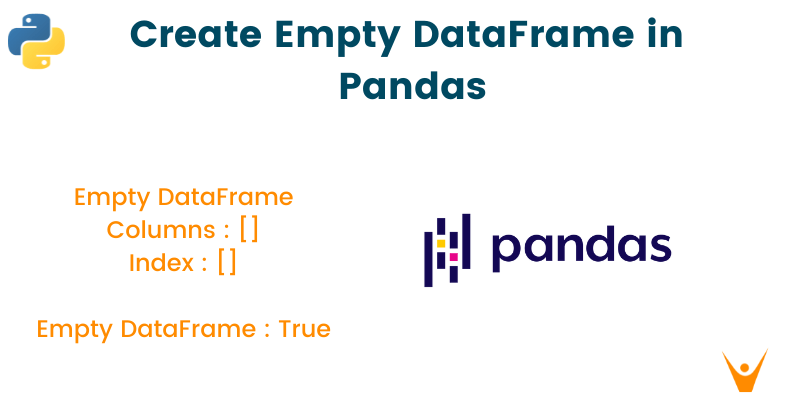DataFrame is a container class that stores and manipulates two-dimensional data organized in tabular format within the python data analysis library 'Pandas'. The data, rows, and columns are the three main components of a Pandas DataFrame. You can store different types of elements in each column of DataFrame. For instance, one column of a DataFrame can have all its elements as integers, while another column can have all its elements as string literals. However, you can make use of the attribute name 'dtype' and return the object type of the column.
Oftentimes, to save memory, we may want to build an empty DataFrame. If you simply want to add records with two values rather than the entire DataFrame, for example, you can construct an empty DataFrame first and then append the values one by one. In this article, you will learn how to create an empty DataFrame in python using pandas. We'll also talk about how to fill it with data later by adding rows or columns. So, let’s get started!
How to Create Empty DataFrame in Pandas?
Below are the three methods by which you can create an empty DataFrame in pandas:
1) Creating a dataframe without rows and columns
You can create an empty dataframe by importing pandas from the python library. Later, using the pd.DataFrame(), create an empty dataframe without rows and columns as shown in the below example. Note that the DataFrame() class available in the pandas library is similar to the constructor which is used to construct the class.
For example:
# import pandas library as pd import pandas as pd # create an Empty DataFrame object df = pd.DataFrame() print(df) # append columns to an empty DataFrame df['Name'] = ['Anna', 'Pete', 'Tommy'] df['Scores'] = [97, 600, 200] df['Questions'] = [2200, 75, 100] df
Output:
Name Scores Questions 0 Anna 97 2200 1 Pete 600 75 2 Tommy 200 100
2) Create an empty dataframe with only columns
The second method is to create an empty dataframe with only columns in it. Later, to complete the DataFrame and add data into it, you can create and append the rows using the in-built append() method as shown in the below example.
For example:
# import pandas library as pd import pandas as pd # create an Empty DataFrame # object With column names only df = pd.DataFrame(columns = ['Name', 'Scores', 'Questions']) print(df) # append rows to an empty DataFrame df = df.append({'Name' : 'Anna', 'Scores' : 97, 'Questions' : 2200}, ignore_index = True) df = df.append({'Name' : 'Linda', 'Scores' : 30, 'Questions' : 50}, ignore_index = True) df = df.append({'Name' : 'Tommy', 'Scores' : 17, 'Questions' : 220}, ignore_index = True)
df
Output:
Empty DataFrame
Columns: [Name, Scoress, Questions]
Index: []
Name Scores Questions
0 Anna 97 2200
1 Linda 30 50
2 Tommy 17 220
3) Create an empty dataframe with column name and indices
Another method is to create the empty dataframe using columns and indices in it. As the indices are passed while creating the DataFrame, you can easily append the rows using the loc() function. It helps to retrieve data values from a dataset that are fitted in particular rows and columns based on index value passed. Check out the below example for a better understanding.
For example:
# import pandas library as pd import pandas as pd # create an Empty DataFrame object With # column names and indices df = pd.DataFrame(columns = ['Name', 'Scores', 'Questions'], index = ['a', 'b', 'c']) print("Empty DataFrame With NaN values : \n\n", df) # adding rows to an empty # dataframe at existing index df.loc['a'] = ['Anna', 50, 100] df.loc['b'] = ['Pete', 60, 120] df.loc['c'] = ['Tommy', 30, 60] df
Output:
Empty DataFrame With NaN values :
Name Scores Questions
a NaN NaN NaN
b NaN NaN NaN
c NaN NaN NaN
Name Scores Questions
a Anna 50 100
b Pete 60 120
c Tommy 30 60
Conclusion
Data Analysis is one of the crucial steps for any programmer in the technical world. Also, many large companies make use of the huge data received from their customers and draw valuable insights from it. In this article, we studied how to create an empty DataFrame and store this large amount of data into it by appending rows and columns. All these methods are simple and highly recommended for making your coding efficient.








